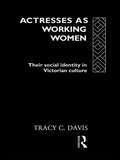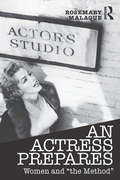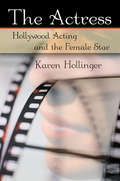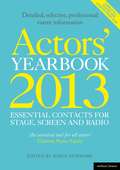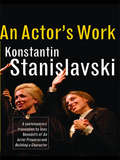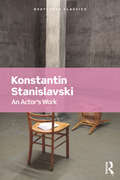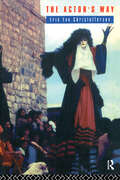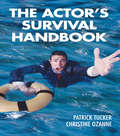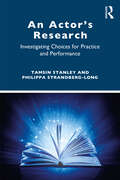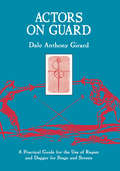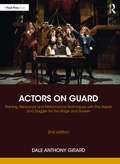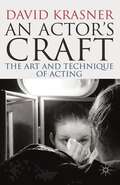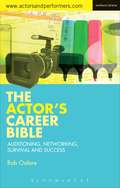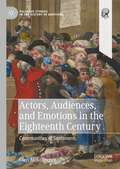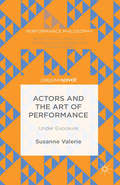- Table View
- List View
Actresses as Working Women: Their Social Identity in Victorian Culture (Gender in Performance)
by Tracy C. DavisUsing historical evidence as well as personal accounts, Tracy C. Davis examines the reality of conditions for `ordinary' actresses, their working environments, employment patterns and the reasons why acting continued to be such a popular, though insecure, profession. Firmly grounded in Marxist and feminist theory she looks at representations of women on stage, and the meanings associated with and generated by them.
An Actress Prepares: Women and "the Method"
by Rosemary Malague'Every day, thousands of women enter acting classes where most of them will receive some variation on the Stanislavsky-based training that has now been taught in the U.S. for nearly ninety years. Yet relatively little feminist consideration has been given to the experience of the student actress: What happens to women in Method actor training?' An Actress Prepares is the first book to interrogate Method acting from a specifically feminist perspective. Rose Malague addresses "the Method" not only with much-needed critical distance, but also the crucial insider's view of a trained actor. Case studies examine the preeminent American teachers who popularized and transformed elements of Stanislavsky’s System within the U.S.—Strasberg, Adler, Meisner, and Hagen— by analyzing and comparing their related but distinctly different approaches. This book confronts the sexism that still exists in actor training and exposes the gender biases embedded within the Method itself. Its in-depth examination of these Stanislavskian techniques seeks to reclaim Method acting from its patriarchal practices and to empower women who act. 'I've been waiting for someone to write this book for years: a thorough-going analysis and reconsideration of American approaches to Stanislavsky from a feminist perspective ... lively, intelligent, and engaging.' – Phillip Zarrilli, University of Exeter 'Theatre people of any gender will be transformed by Rose Malague’s eye-opening study An Actress Prepares... This book will be useful to all scholars and practitioners determined to make gender equity central to how they hone their craft and their thinking.' – Jill Dolan, Princeton University
An Actress Prepares: Women and "the Method"
by Rosemary Malague'Every day, thousands of women enter acting classes where most of them will receive some variation on the Stanislavsky-based training that has now been taught in the U.S. for nearly ninety years. Yet relatively little feminist consideration has been given to the experience of the student actress: What happens to women in Method actor training?' An Actress Prepares is the first book to interrogate Method acting from a specifically feminist perspective. Rose Malague addresses "the Method" not only with much-needed critical distance, but also the crucial insider's view of a trained actor. Case studies examine the preeminent American teachers who popularized and transformed elements of Stanislavsky’s System within the U.S.—Strasberg, Adler, Meisner, and Hagen— by analyzing and comparing their related but distinctly different approaches. This book confronts the sexism that still exists in actor training and exposes the gender biases embedded within the Method itself. Its in-depth examination of these Stanislavskian techniques seeks to reclaim Method acting from its patriarchal practices and to empower women who act. 'I've been waiting for someone to write this book for years: a thorough-going analysis and reconsideration of American approaches to Stanislavsky from a feminist perspective ... lively, intelligent, and engaging.' – Phillip Zarrilli, University of Exeter 'Theatre people of any gender will be transformed by Rose Malague’s eye-opening study An Actress Prepares... This book will be useful to all scholars and practitioners determined to make gender equity central to how they hone their craft and their thinking.' – Jill Dolan, Princeton University
The Actress: Hollywood Acting and the Female Star
by Karen HollingerThe Actress: Hollywood Acting and the Female Star investigates the contemporary film actress both as an artist and as an ideological construct. Divided into two sections, The Actress first examines the major issues in studying film acting, stardom, and the Hollywood actress. Combining theories of screen acting and of film stardom, The Actress presents a synthesis of methodologies and offers the student and scholar a new approach to these two subjects of study.
The Actress: Hollywood Acting and the Female Star
by Karen HollingerThe Actress: Hollywood Acting and the Female Star investigates the contemporary film actress both as an artist and as an ideological construct. Divided into two sections, The Actress first examines the major issues in studying film acting, stardom, and the Hollywood actress. Combining theories of screen acting and of film stardom, The Actress presents a synthesis of methodologies and offers the student and scholar a new approach to these two subjects of study.
Actors' Yearbook 2013 - Essential Contacts for Stage, Screen and Radio
by Hilary Lissenden Simon DunmoreActors' Yearbook is an established and respected directory that enables actors to find work in stage, screen and radio. It is the only directory to provide detailed information for each listing and specific advice on how to approach companies and individuals, saving hours of further research. From agents and casting directors to producing theatres, showreel companies and photographers, Actors' Yearbook editorially selects only the most relevant and reputable contacts for the actor.Articles and commentaries provide valuable insight into the profession: auditions, interviews and securing work alongside a casting calendar and advice on contracts and finance. This is an incredibly useful professional tool in an industry where contacts and networking are key to career survival.The listings detailed in this edition have been thoroughly updated alongside fresh advice from industry experts.
An Actor's Work: A Student's Diary
by Konstantin StanislavskiStanislavski’s ‘system’ has dominated actor-training in the West since his writings were first translated into English in the 1920s and 30s. His systematic attempt to outline a psycho-physical technique for acting single-handedly revolutionized standards of acting in the theatre. Until now, readers and students have had to contend with inaccurate, misleading and difficult-to-read English-language versions. Some of the mistranslations have resulted in profound distortions in the way his system has been interpreted and taught. At last, Jean Benedetti has succeeded in translating Stanislavski’s huge manual into a lively, fascinating and accurate text in English. He has remained faithful to the author's original intentions, putting the two books previously known as An Actor Prepares and Building A Character back together into one volume, and in a colloquial and readable style for today's actors. The result is a major contribution to the theatre, and a service to one of the great innovators of the twentieth century.
An Actor's Work: A Student's Diary
by Konstantin StanislavskiStanislavski’s ‘system’ has dominated actor-training in the West since his writings were first translated into English in the 1920s and 30s. His systematic attempt to outline a psycho-physical technique for acting single-handedly revolutionized standards of acting in the theatre. Until now, readers and students have had to contend with inaccurate, misleading and difficult-to-read English-language versions. Some of the mistranslations have resulted in profound distortions in the way his system has been interpreted and taught. At last, Jean Benedetti has succeeded in translating Stanislavski’s huge manual into a lively, fascinating and accurate text in English. He has remained faithful to the author's original intentions, putting the two books previously known as An Actor Prepares and Building A Character back together into one volume, and in a colloquial and readable style for today's actors. The result is a major contribution to the theatre, and a service to one of the great innovators of the twentieth century.
An Actor's Work (Routledge Classics)
by Konstantin StanislavskiStanislavski’s ‘system’ has dominated actor-training in the West since his writings were first translated into English in the 1920s and 30s. His systematic attempt to outline a psycho-physical technique for acting single-handedly revolutionized standards of acting in the theatre. Until now, readers and students have had to contend with inaccurate, misleading and difficult-to-read English-language versions. Some of the mistranslations have resulted in profound distortions in the way his system has been interpreted and taught. At last, Jean Benedetti has succeeded in translating Stanislavski’s huge manual into a lively, fascinating and accurate text in English. He has remained faithful to the author's original intentions, putting the two books previously known as An Actor Prepares and Building A Character back together into one volume, and in a colloquial and readable style for today's actors. The result is a major contribution to the theatre, and a service to one of the great innovators of the twentieth century. This Routledge Classics edition includes a new Foreword by the director Richard Eyre.
An Actor's Work: A Student's Diary (Routledge Classics)
by Konstantin StanislavskiStanislavski’s ‘system’ has dominated actor-training in the West since his writings were first translated into English in the 1920s and 30s. His systematic attempt to outline a psycho-physical technique for acting single-handedly revolutionized standards of acting in the theatre. Until now, readers and students have had to contend with inaccurate, misleading and difficult-to-read English-language versions. Some of the mistranslations have resulted in profound distortions in the way his system has been interpreted and taught. At last, Jean Benedetti has succeeded in translating Stanislavski’s huge manual into a lively, fascinating and accurate text in English. He has remained faithful to the author's original intentions, putting the two books previously known as An Actor Prepares and Building A Character back together into one volume, and in a colloquial and readable style for today's actors. The result is a major contribution to the theatre, and a service to one of the great innovators of the twentieth century. This Routledge Classics edition includes a new Foreword by the director Richard Eyre.
The Actor's Way
by Erik Exe ChristoffersenCan 'stage presence' be acquired? Why do some actors appear more dynamic in performance than others? In The Actors Way four experienced actors talk about the secrets and the practical realities of over twenty-five years of theatre training with Odin Teatret. Under the unique direction of Eugenio Barba, director of Odin Teatret, they have explored issues such as the connections between physical and mental work on stage, how to gain and control the spectator's attention, and intercultural performance techniques. The Actor's Way is a fascinating account of personal and professional development in the theatre. It will be vital reading for drama students and actors, but enjoyable and illuminating for anyone interested in the craft of acting.
The Actor's Way
by Erik Exe ChristoffersenCan 'stage presence' be acquired? Why do some actors appear more dynamic in performance than others? In The Actors Way four experienced actors talk about the secrets and the practical realities of over twenty-five years of theatre training with Odin Teatret. Under the unique direction of Eugenio Barba, director of Odin Teatret, they have explored issues such as the connections between physical and mental work on stage, how to gain and control the spectator's attention, and intercultural performance techniques. The Actor's Way is a fascinating account of personal and professional development in the theatre. It will be vital reading for drama students and actors, but enjoyable and illuminating for anyone interested in the craft of acting.
The Actor's Survival Handbook
by Patrick Tucker Christine OzanneWorried about short rehearsal time? Think that fluffing your lines will be the end of your career? Are you afraid you'll be typecast? Is there such a thing as acting too much? How should a stage actor adjust performance for a camera? And how should an actor behave backstage?The Actor's Survival Handbook gives you answers to all these questions and many more. Written with verve and humor, this utterly essential tool speaks to every actor's deepest concerns. Drawing upon their years of experience on stage, backstage, and with the camera, Patrick Tucker and Christine Ozanne offer forthright advice on topics from breathing to props, commitment to learning lines, audience response to simply landing the job in the first place. The book is rich with examples - both technical and inspirational. And because a director and an actor won't always agree, the two writers sometimes even offer alternative responses to a dilemma, giving the reader both an actor's take and a director's take on a particular point.Like Patrick Tucker's Secrets of Screen Acting, this new book is written with wit and passion, conveying the authors' powerful conviction that success is within every actor's grasp.
The Actor's Survival Handbook
by Patrick Tucker Christine OzanneWorried about short rehearsal time? Think that fluffing your lines will be the end of your career? Are you afraid you'll be typecast? Is there such a thing as acting too much? How should a stage actor adjust performance for a camera? And how should an actor behave backstage?The Actor's Survival Handbook gives you answers to all these questions and many more. Written with verve and humor, this utterly essential tool speaks to every actor's deepest concerns. Drawing upon their years of experience on stage, backstage, and with the camera, Patrick Tucker and Christine Ozanne offer forthright advice on topics from breathing to props, commitment to learning lines, audience response to simply landing the job in the first place. The book is rich with examples - both technical and inspirational. And because a director and an actor won't always agree, the two writers sometimes even offer alternative responses to a dilemma, giving the reader both an actor's take and a director's take on a particular point.Like Patrick Tucker's Secrets of Screen Acting, this new book is written with wit and passion, conveying the authors' powerful conviction that success is within every actor's grasp.
An Actor’s Research: Investigating Choices for Practice and Performance
by Tamsin Stanley Philippa Strandberg-LongAn Actor’s Research: Investigating Choices for Practice and Performance presents an accessible and highly practical guide to the research approaches required of the actor. It aims to establish the precision and rigour of the actor’s craft that is intrinsic to a compelling acting performance, explore a range of research activities surrounding and emerging from practical work in the studio, and enable the actor to evolve a multifaceted skillset in researching for performance. The chapters focus on different research areas such as the self, character, relationships, circumstance, and context, providing accessible and practical guidance to developing a personal research practice. Each aspect is explained and engaged with as practice, rather than study – offering helpful hints and advising against common pitfalls – ultimately enabling the actor to locate the necessary knowledge to shape and inform their performance in both text-based and devised scenarios. Additionally, as the actor’s self is a personal instrument that is drawn on in terms of expression, impulses, and imagination; the self also becomes a source for creative appraisal and research. This book therefore offers comprehensive advice and strategies for self-evaluation and reflection, connecting research investigation with self-exploration in making expressive performance choices, making it a practice highly applicable to the actor’s needs. An Actor’s Research closely follows the training actor’s needs in terms of performance-based research; however, its practical research activities for text and character creation and strategies for the development of critical thinking and self-reflective skills support the ongoing development of the actor and their craft in both training and professional circumstances.
An Actor’s Research: Investigating Choices for Practice and Performance
by Tamsin Stanley Philippa Strandberg-LongAn Actor’s Research: Investigating Choices for Practice and Performance presents an accessible and highly practical guide to the research approaches required of the actor. It aims to establish the precision and rigour of the actor’s craft that is intrinsic to a compelling acting performance, explore a range of research activities surrounding and emerging from practical work in the studio, and enable the actor to evolve a multifaceted skillset in researching for performance. The chapters focus on different research areas such as the self, character, relationships, circumstance, and context, providing accessible and practical guidance to developing a personal research practice. Each aspect is explained and engaged with as practice, rather than study – offering helpful hints and advising against common pitfalls – ultimately enabling the actor to locate the necessary knowledge to shape and inform their performance in both text-based and devised scenarios. Additionally, as the actor’s self is a personal instrument that is drawn on in terms of expression, impulses, and imagination; the self also becomes a source for creative appraisal and research. This book therefore offers comprehensive advice and strategies for self-evaluation and reflection, connecting research investigation with self-exploration in making expressive performance choices, making it a practice highly applicable to the actor’s needs. An Actor’s Research closely follows the training actor’s needs in terms of performance-based research; however, its practical research activities for text and character creation and strategies for the development of critical thinking and self-reflective skills support the ongoing development of the actor and their craft in both training and professional circumstances.
Actors on Guard: A Practical Guide for the Use of the Rapier and Dagger for Stage and Screen
by Dale Anthony GirardActors on Guard is the most comprehensive and detailed book on the art of theatrical swordplay available today. It provides the reader with the historical, theoretical and practical basis for learning, practicing and presenting theatrical sword fights. Focusing specifically on the Elizabethan rapier and dagger (the most popular weapons used in stage fights), Actors on Guard provides actors, directors, teachers, stage managers and technicians the skills and knowledge essential to presenting safe and effective fights, both for stage and screen.
Actors on Guard: A Practical Guide for the Use of the Rapier and Dagger for Stage and Screen
by Dale Anthony GirardActors on Guard is the most comprehensive and detailed book on the art of theatrical swordplay available today. It provides the reader with the historical, theoretical and practical basis for learning, practicing and presenting theatrical sword fights. Focusing specifically on the Elizabethan rapier and dagger (the most popular weapons used in stage fights), Actors on Guard provides actors, directors, teachers, stage managers and technicians the skills and knowledge essential to presenting safe and effective fights, both for stage and screen.
Actors on Guard: Training, Rehearsal and Performance Techniques with the Rapier and Dagger for the Stage and Screen
by Dale Anthony GirardActors on Guard, Second Edition is the most comprehensive book covering the current practices in learning, rehearsing and performing safe and dynamic swordfights with the single rapier and the rapier and dagger for both stage and screen.Focusing specifically on the Elizabethan rapier and dagger – the most popular weapons used in stage fights – Actors on Guard provides actors, directors, teachers, stage managers and technicians the skills and knowledge essential to presenting safe and effective swordfights. The book takes the reader through the complex process of selecting safe stage weapons, learning the basic handling and management of the rapier and dagger, as well as how to safely move and interact in the potentially dangerous process of learning, rehearsing and performing choreographed swordplay. This new edition has been revised with current industry practices, featuring hundreds of step-by-step practical exercises in the care and handling of prop swords, footwork, guards, parries, cutting and thrusting techniques, blade taking actions, disarms, wounds and kills using the rapier and dagger, with revised diagrams and photographs.An excellent sourcebook for university stage combat classes as well as self-learners, Actors on Guard provides the reader with the historical, theoretical and practical basis for mastering the art of sword fighting for the stage and screen.The book includes access to a wealth of online resources, with additional information that expands upon specific mechanics, techniques and concepts covered in the text as well as some video demonstrations of solo and partnered techniques and exercises.
Actors on Guard: Training, Rehearsal and Performance Techniques with the Rapier and Dagger for the Stage and Screen
by Dale Anthony GirardActors on Guard, Second Edition is the most comprehensive book covering the current practices in learning, rehearsing and performing safe and dynamic swordfights with the single rapier and the rapier and dagger for both stage and screen.Focusing specifically on the Elizabethan rapier and dagger – the most popular weapons used in stage fights – Actors on Guard provides actors, directors, teachers, stage managers and technicians the skills and knowledge essential to presenting safe and effective swordfights. The book takes the reader through the complex process of selecting safe stage weapons, learning the basic handling and management of the rapier and dagger, as well as how to safely move and interact in the potentially dangerous process of learning, rehearsing and performing choreographed swordplay. This new edition has been revised with current industry practices, featuring hundreds of step-by-step practical exercises in the care and handling of prop swords, footwork, guards, parries, cutting and thrusting techniques, blade taking actions, disarms, wounds and kills using the rapier and dagger, with revised diagrams and photographs.An excellent sourcebook for university stage combat classes as well as self-learners, Actors on Guard provides the reader with the historical, theoretical and practical basis for mastering the art of sword fighting for the stage and screen.The book includes access to a wealth of online resources, with additional information that expands upon specific mechanics, techniques and concepts covered in the text as well as some video demonstrations of solo and partnered techniques and exercises.
An Actor's Craft: The Art and Technique of Acting
by David KrasnerThis inspirational guide for advanced acting students brings together multiple ways of creating excellence in performance. David Krasner provides tried and tested exercises, a history of actor training and explores the complex relationships between acting theories and teachers. Drawing on examples from personal experience as an actor, director and teacher, An Actor's Craft begins with the building blocks of mind, body and voice, moving through emotional triggers and improvisation, to a final section bringing these techniques together in approaching a role. Each chapter contains accompanying exercises that the actor should practice daily. Combining theory and practice, this thought-provoking and challenging study of acting techniques and theories is for actors who have grasped the basics and now want to develop their knowledge and training further.
The Actor's Career Bible: Auditioning, Networking, Survival and Success
by Rob OstlereThe Actor's Career Bible is a practical guide to building an acting career. Based on a huge range of interviews with actors of all backgrounds at every level of the profession, industry experts, key organisations, casting directors, agents, producers, directors and many others, this guide covers all the essentials as well as sharing exclusive inside knowledge. Whether you're a recent graduate, a young actor or an experienced professional, The Actor's Career Bible will help you kick-start or reinvigorate your career in an industry famous for its high levels of competition. This in-depth guide will show you how to cope with the pressures and strains of being an actor and offers easy-to-follow advice on how to improve your chances of success.
The Actor's Career Bible: Auditioning, Networking, Survival and Success
by Rob OstlereThe Actor's Career Bible is a practical guide to building an acting career. Based on a huge range of interviews with actors of all backgrounds at every level of the profession, industry experts, key organisations, casting directors, agents, producers, directors and many others, this guide covers all the essentials as well as sharing exclusive inside knowledge. Whether you're a recent graduate, a young actor or an experienced professional, The Actor's Career Bible will help you kick-start or reinvigorate your career in an industry famous for its high levels of competition. This in-depth guide will show you how to cope with the pressures and strains of being an actor and offers easy-to-follow advice on how to improve your chances of success.
Actors, Audiences, and Emotions in the Eighteenth Century: Communities of Sentiment (Palgrave Studies in the History of Emotions)
by Glen McGillivrayThis book offers an innovative account of how audiences and actors emotionally interacted in the English theatre during the middle decades of the eighteenth century, a period bookended by two of its stars: David Garrick and Sarah Siddons. Drawing upon recent scholarship on the history of emotions, it uses practice theory to challenge the view that emotional interactions between actors and audiences were governed by empathy. It carefully works through how actors communicated emotions through their voices, faces and gestures, how audiences appraised these performances, and mobilised and regulated their own emotional responses. Crucially, this book reveals how theatre spaces mediated the emotional practices of audiences and actors alike. It examines how their public and frequently political interactions were enabled by these spaces.
Actors and the Art of Performance: Under Exposure (Performance Philosophy)
by Susanne GranzerActors and the Art of Performance: Under Exposure combines the author's two main biographical paths: her professional commitment to the fields of both theatre and philosophy. The art of acting on stage is analysed here not only from the theoretical perspective of a spectator, but also from the perspective of the actor. The author draws on her experience as both a theatre actor and a university professor whose teachings in the art of acting rely heavily on her own experience and also on her philosophical knowledge. The book is unique not only in terms of its content but also in terms of its style. Written in a multiplicity of voices, the text oscillates between philosophical reasoning and narrative forms of writing, including micro-narratives, fables, parables, and inter alia by Carroll, Hoffmann and Kleist. Hence the book claims that a trans-disciplinary dialogue between the art of acting and the art of philosophical thinking calls for an aesthetical research that questions and begins to seek alternatives to traditionally established and ingrained formats of philosophy.
